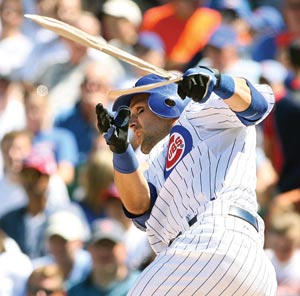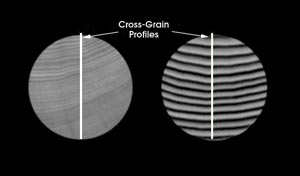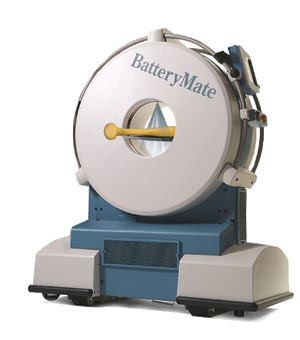
Science at the Crack of the Bat
Lynn Savage
If you’re a baseball fan, you’ve seen bats splintering all over major league parks the past couple of seasons. Not just cracking or breaking into two pieces, becoming expensive kindling, but shattering into shards that have sliced, stabbed or broken the bones of players, umps and fans in the stands.

Mark DeRosa of the Chicago Cubs splinters his bat during a game in 2007.
The alleged culprit in all of this mayhem is the wood from maple trees, which is used to make about half the bats used today by professional players. Several kinds of wood have been used to make bats – beginning with hickory during the early years of pro ball — but players’ preferences have turned from ash to maple. The common complaint about ash’s toughness is that the barrel of a bat chips away over time. Maple is denser, and thus harder to chip, than ash. Hickory lost favor decades ago because it is so dense that it is too heavy to use comfortably.
All bats fail after long use because a lot of force – from strong athletes using them to strike balls thrown 80 to 100 mph – acts upon them. Major League Baseball (MLB) is taking an official look at why maple bats tend to splinter into ragged bits of wood rather than just crack or chip, but Universal Medical Systems Inc. of Solon, Ohio, has provided the means to get a direct answer.
The company, which supplies computed tomography (CT) systems to the medical and veterinarian fields, has adapted a CT scanner developed by NeuroLogica Corp. of Danvers, Mass., to help reveal the internal structure of baseball bats.

Computed tomography has shown that maple grain (left) is denser and more uniform than that of ash (right). Courtesy of Universal Medical Systems Inc.
After retuning NeuroLogica’s CereTom device, then adding a positioning adapter and a specialized analysis program, Universal Medical Systems had BatteryMate. According to the latter company’s president, David R. Zavagno, the system would be useful to anyone who handles bats – from manufacturers to team equipment managers to individual players. A simple 30-s scan would reveal whether a bat had been made with otherwise invisible defects that likely would lead to breakage during play.

The BatteryMate is a computed tomography system adapted to examine the structure of baseball bats, providing information about whether a bat’s internal structure makes it prone to shattering during play. Courtesy of Universal Medical Systems Inc.
The MLB may ban maple altogether, or dictate changes in the shape of bats so that breakage is less common, but the BatteryMate may yet find use in other leagues or on the factory floors of the dozens of manufacturers who make bats.
Published: September 2008